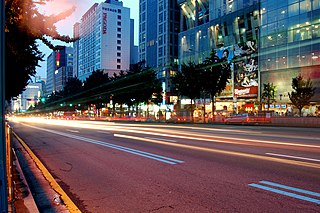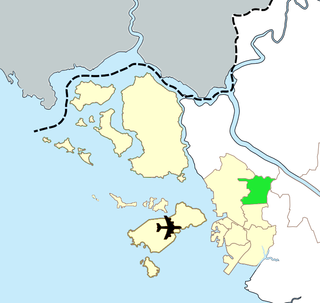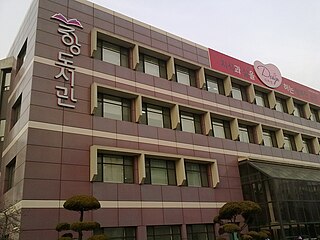
Incheon, formerly Jemulpo or Chemulp'o (제물포) until the period after 1910, officially the Incheon Metropolitan City, is a city located in northwestern South Korea, bordering Seoul and Gyeonggi to the east. Inhabited since the Neolithic, Incheon was home to just 4,700 people when it became an international port in 1883. Today, about 3 million people live in the city, making it South Korea's third-most-populous city after Seoul and Busan.

The Gyeongin Expressway, officially Expressway No. 120, is an expressway in South Korea connecting the Yangcheon District of Seoul to the Nam District of Incheon. It is the oldest expressway in South Korea.

Gwangmyeong is a city in Gyeonggi Province, South Korea. It borders Seoul to the east, north and northeast, Anyang to the southeast, Siheung to the southwest, and Bucheon to the northeast.

Yeongdeungpo District is an administrative district in southwest Seoul, South Korea. Although the origin of the name is uncertain, the first two syllables are thought to be from "yeongdeung" (靈登) or "divine ascent", a shamanic rite. The third syllable is "po", representing the bank of a river (浦), referring to the district's position on the Han River. The 2006 population was 408,819.

Seodaemun District is one of the 25 districts of Seoul, South Korea.

Seohyeon-dong refers to two of the 19 dongs of Bundang-gu, Seongnam, South Korea, Seohyeon-1-dong and Seohyeon-2-dong. The total area is 8.36 km², with a population of 52,950, 32,686 in Seohyeon-1-dong (7.57 km²)[](May 2014) and 20,264 in Seohyeon-2-dong (0.79 km²)[](May 2014). To the south, there is Sunae-dong, to north there is Imae-dong, to west there are Baekhyeon-dong and Pangyo-dong, to east there are Bundang-dong and Gwangju city. It includes the busiest place in Bundang, AK Plaza. Ak plaza's clock tower is the most famous meeting place in Bundang.
Yeonhui-dong (Korean: 연희동) is a dong (neighbourhood) at the center of Seodaemun-gu in Seoul, South Korea. It is an area in Seoul near Yonsei university, and actually the name Yonsei comes from the combination of Yeonhui and Severance.

Seo District (Seo-gu) is the largest district in Incheon, South Korea. It has an area 111.2 square kilometres (42.9 sq mi), and it has the largest area of farmland in Incheon.

Gyeyang District is a ward in Incheon, South Korea.

Bupyeong District is one of the 10 administrative divisions that comprise Incheon, South Korea. Bupyeong District comprises an area of 12.35 square miles, and has a population of 508,587. It is located north of Namdong District, east of Seo District, and south of Gyeyang District. The city of Bucheon, in neighboring Gyeonggi Province, comprises its eastern limit.

Jung District is the historic central ward of the city of Incheon, South Korea, one of the eight wards into which Incheon is divided. Its name means "central" in Korean. It was founded in 1883 on the opening of the Jemulpo Port and contains several historical and cultural heritage monuments, such as Dap-dong Cathedral, Hongyemun Gate, The First Anglican Church, and Jayu Park, Korea's first modern park.

Dong District is a ward in Incheon, South Korea.

Namdong District (Namdong-gu) is a municipal district in Incheon, South Korea. Namdong-gu has been the city centre of Incheon since 1985. It is the location for Incheon Metropolitan City Hall, Incheon Metropolitan Police Agency main offices, the Namdong Industrial Complex, and Gil Hospital & Gachon Medical School. There is a large shopping district close to the City Hall and Grand Theater containing 3 large department stores, many restaurants and bars and the 2.68 km (1.67 mi) long Jung-Ang city park.

Yangjae-dong is a dong, neighbourhood of the greater Gangnam area Seocho District in Seoul, South Korea. Yangjae-dong is divided into 2 different dong which are Yangjae 1-dong and 2-dong.

Postal codes in South Korea are composed of five digits. A new system of post codes was introduced on August 1, 2015. The first postal code in South Korea was established on July 1, 1970, and has been revised three times: in 1988, 2000, and 2015.

Wongok-dong is neighbourhood of Danwon-gu, Ansan, Gyeonggi Province, South Korea. It is officially divided into Wongok-1-dong, Wongok-2-dong and Wongok-bondong. The multi cultural special zone (town) is located in wongok-dong. In multi culture town 70% of the people are foreign and 30% of the people are Korean. Wongok-dong has the widest forest area of 34km. The farmland is 18.8km, which is small compared to the total area.
Yeonhui-dong may refer to

Seoul Overseas Chinese High School or Hanseong Chinese Middle and High School is a Republic of China (Taiwan)-oriented Chinese international junior and senior high school in Seodaemun District, Seoul, South Korea. It follows the curriculum of the ROC, and accordingly uses textbooks from Taiwan.

Geomdan Sageori Station is an underground station on Line 2 of the Incheon Subway in Seo District, Incheon, South Korea. The station subname is Good Node Hospital. After its opening on July 30, 2016, the survey of passengers showed that Incheon Metropolitan Subway Line 2 had the most passengers, but at present, Seo-gu Office station surpassed the number of users. The "Sageori" means "intersection" in Korean.
Hagik Station is an under-construction railway station on Suin-Bundang Line of the Seoul Metropolitan Subway system.
















